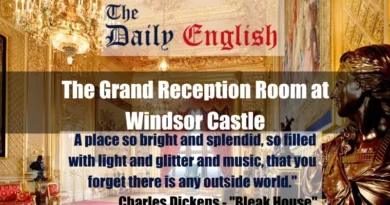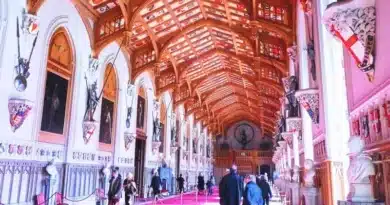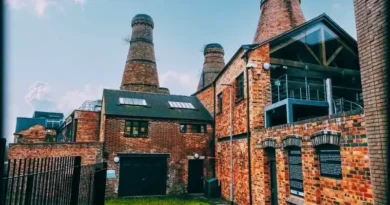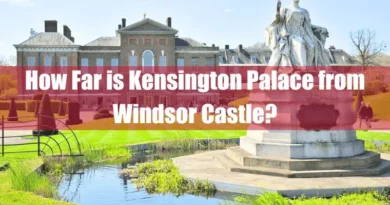How Many Chapels Are There at Windsor Castle?
Windsor Castle contains three chapels:
- St. George’s Chapel: The most prominent and historically significant chapel, known for royal weddings and funerals and as the home of the Order of the Garter.
- Albert Memorial Chapel: A richly decorated chapel originally intended as a shrine to Prince Albert, adjacent to St. George’s Chapel.
- Private Chapel: Located within the State Apartments, this chapel is used by the Royal Family for private worship.
These chapels serve both public and private religious functions for the British monarchy.
Key Takeaways
| Key Takeaways |
|---|
| Windsor Castle, a symbol of British royalty, is home to three chapels, each serving distinct roles and carrying unique historical significance. |
| St. George’s Chapel, founded in 1348, is the spiritual home of the Order of the Garter and an iconic example of Perpendicular Gothic architecture. |
| St. George’s Chapel is the site of significant royal events, including weddings, funerals, and christenings, and houses the tombs of notable monarchs such as Henry VIII and Queen Elizabeth II. |
| The annual Garter Day service, held in St. George’s Chapel, highlights its enduring importance to the monarchy. |
| The Albert Memorial Chapel, originally built as the Lady Chapel, was transformed by Queen Victoria into a memorial for Prince Albert after his death. |
| The Albert Memorial Chapel features elaborate Victorian Gothic Revival decorations, including Italian marble, mosaics, and stained glass, showcasing Queen Victoria’s devotion to Prince Albert. |
| Unlike St. George’s Chapel, the Albert Memorial Chapel is not used for regular worship but serves as a commemorative space. |
| The Private Chapel, located within the State Apartments, provides a secluded space for the Royal Family’s private worship and ceremonies. |
| The Private Chapel, significantly damaged in the 1992 Windsor Castle fire, was meticulously restored by 1997. |
| Windsor Castle’s chapels blend public and private religious functions, reflecting the deep connection between the British monarchy and the Church of England. |
Let’s explore this in detail:
The Chapels of Windsor Castle: A Detailed Overview

Windsor Castle, one of the most iconic royal residences in the United Kingdom, symbolises British royalty and is a site of deep religious significance. The castle is home to three chapels, each with its unique history and role within the castle complex. This article provides an in-depth look at these chapels, supported by reliable sources.
1. St. George’s Chapel: The Heart of Windsor Castle
St. George’s Chapel is the largest and most prominent chapel in Windsor Castle in the Lower Ward. It is one of England’s most important religious sites, serving as a place of worship, celebration, and remembrance for the British monarchy.
Foundation and Historical Significance: Founded in 1348 by King Edward III, the chapel was initially intended to be the spiritual home of the Order of the Garter, England’s highest order of chivalry. The construction of the current chapel began under King Edward IV in 1475 and was completed by Henry VIII in 1528.
Architectural Highlights: St. George’s Chapel is an exquisite example of Perpendicular Gothic architecture, characterised by its soaring fan-vaulted ceiling, intricate stone carvings, and magnificent stained glass windows. The chapel’s quire is particularly notable, featuring stalls adorned with the heraldic banners of the Knights of the Garter.
Royal Events and Burials: St. George’s Chapel has been the site of numerous significant royal events, including weddings, funerals, and christenings. It is the final resting place of many British monarchs, including Henry VIII, Charles I, George VI, and, most recently, Queen Elizabeth II. The annual Garter Day service, where new members of the Order of the Garter are invested, is one of the most important events held in the chapel.

2. Albert Memorial Chapel: A Tribute to Prince Albert
Adjacent to St. George’s Chapel lies the Albert Memorial Chapel, a smaller yet richly decorated chapel with deep historical significance. The chapel was originally built during the reign of King Henry VII as Lady Chapel. Still, its construction largely occurred during the reign of his son, Henry VIII. It was associated with Cardinal Wolsey, but the chapel was never fully completed according to his plans. After the death of Prince Albert in 1861, Queen Victoria transformed this chapel into a memorial for her beloved husband, renaming it the Albert Memorial Chapel.
Design and Decoration: Under Queen Victoria’s orders, the chapel underwent extensive renovations, including adding Italian marble, intricate mosaics, and other lavish decorations. The interior showcases the Victorian Gothic Revival style, distinct from St. George’s Chapel’s more traditional Gothic architecture. The chapel features stained glass windows, marble from various European sources, and detailed bas-relief decorations, reflecting Prince Albert’s values and Victorian artistic innovation.
Function: Unlike St. George’s Chapel, the Albert Memorial Chapel is unused for regular worship services. Instead, it serves as a commemorative space dedicated to preserving the memory of Prince Albert. Its elaborate design and personal connection to Queen Victoria make it a unique and significant part of Windsor Castle’s history.
3. The Private Chapel: A Sanctuary for the Royal Family
The Private Chapel within Windsor Castle is a more secluded and lesser-known space reserved for the private use of the Royal Family. Located within the State Apartments, this chapel is not accessible to the public and is used for private worship and ceremonies.
Historical Context: The Private Chapel has been a part of the castle’s history for centuries, although it gained particular attention after the devastating fire of 1992. The fire caused extensive damage to the chapel and other parts of the castle. The subsequent restoration work, completed by 1997, carefully restored the chapel to its former glory.
Current Use: The Private Chapel continues to serve as a place of personal worship and reflection for the Royal Family. It is used for intimate ceremonies, not intended for public viewing, maintaining its role as a private sanctuary within the castle.
Conclusion
Windsor Castle’s three chapels—St. George’s Chapel, Albert Memorial Chapel, and the Private Chapel serve distinct roles within the castle’s complex. St. George’s Chapel remains a public symbol of royal heritage and the spiritual home of the Order of the Garter. The Albert Memorial Chapel is a richly decorated tribute to Prince Albert, reflecting Queen Victoria’s deep love for her husband. On the other hand, the Private Chapel provides a quiet place for the Royal Family to worship and reflect away from the public eye.
These chapels are integral to the history and ongoing life of Windsor Castle, highlighting the deep connections between the British monarchy and the Church of England.
The blend of public and private religious functions within the castle underscores Windsor Castle’s unique role as both a royal residence and a sacred space.
FAQ
What are the visiting hours for St. George’s Chapel?
St. George’s Chapel is open to visitors on Monday, Thursday, Friday, and Saturday from 10:00 to 16:00. Access may be limited after 14:30 due to high visitor numbers. The chapel is closed to visitors on Sundays but open for worship services.
Can I attend a service at St. George’s Chapel?
Yes, visitors are welcome to attend Evensong at 17:15. On Sundays, the chapel is closed to visitors but open to worshippers for services.
Is photography allowed inside St. George’s Chapel?
Photography is prohibited inside St. George’s Chapel to preserve its sacred atmosphere and protect the historic interiors.
Who is buried in St. George’s Chapel?
St. George’s Chapel is the final resting place of numerous monarchs, including Henry VIII, Charles I, and, more recently, Queen Elizabeth II and Prince Philip.
What is the significance of the Order of the Garter in St. George’s Chapel?
St. George’s Chapel is the spiritual home of the Order of the Garter, the oldest order of chivalry in Britain, with annual services traditionally held in June.
Can I visit the Albert Memorial Chapel?
Visitors can view the Albert Memorial Chapel from its entrance after visiting St. George’s Chapel; entry into the chapel itself is not permitted.
What is the history of the Albert Memorial Chapel?
Originally a 13th-century chapel, it was refurbished by Queen Victoria as a memorial to Prince Albert and opened to visitors in 1875.
What are the notable features of the Albert Memorial Chapel?
The chapel is renowned for its rich decorations, including mosaics, marble, and stained glass, making it a veritable treasure house of art.
Is the Private Chapel open to the public?
No, the private chapel within the state apartments is reserved for the royal family’s private worship and is inaccessible to the public.
What is the capacity of the Private Chapel?
The current private chapel accommodates approximately 30 people and features red giltwood chairs instead of traditional pews.
How can I purchase tickets to visit St. George’s Chapel?
Tickets can be purchased through the Royal Collection Trust’s official website or on-site, subject to availability.
Are there any dress code requirements for visiting the chapels?
Visitors are expected to dress respectfully and wear appropriate attire for a place of worship; comfortable shoes are recommended due to the castle’s terrain.
Is there wheelchair access to St. George’s Chapel?
Yes, St. George’s Chapel is accessible to wheelchair users; however, the castle’s steep hill and long distances should be considered.
Is there a gift shop at St. George’s Chapel?
Yes, there are gift shops within Windsor Castle offering a range of souvenirs related to the chapel and the Royal Family.
Can I attend Evensong at St. George’s Chapel without a castle ticket?
Yes, attending Evensong at 17:15 is free of charge; however, access to the service is limited, and visitors should arrive promptly.









